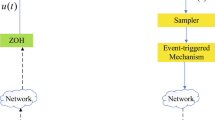Abstract
This work presents a sensor-fault-tolerant design applied to a decentralized dissolved oxygen control in an activated sludge process subject to sensor faults such as bias and slow drifts. The core idea is to use a data-driven soft sensor based on adaptive neuro-fuzzy inference system to act as a backup of the joint sensor and controller block, and to exploit the data/analytical correlations existing in the system. After fault detection and isolation, a control reconfiguration technique takes action in order to surmount/counteract the effect of the fault until the faulty sensor is repaired. The approach presented here was applied to the Benchmark Simulation Model n.1 and was able to demonstrate the improvements on the control system dependability.









Similar content being viewed by others
References
Alex J, Benedetti L, Copp J, Gernaey KV, Jeppsson U, Nopens I, Pons MN, Rieger L, Rosen C, Steyer JP, Vanrolleghem P, Winkler S (2008) Benchmark simulation model no. 1 (bsm1). Technical Report LTH-IEA-7229. Department of Industrial Electrical Engineering and Automation, Lund University, Lund
Aouaouda S, Chadli M, Khadir MT, Bouarar T (2012) Robust fault tolerant tracking controller design for unknown inputs T–S models with unmeasurable premise variables. J Process Control 22(5):861–872. doi:10.1016/j.jprocont.2012.02.016
Belchior CAC, Araújo RAM, Landeck JAC (2012) Dissolved oxygen control of the activated sludge wastewater treatment process using stable adaptive fuzzy control. Comput Chem Eng 37:152–162. doi:10.1016/j.compchemeng.2011.09.011
Bolles S (2006) Modeling wastewater aeration systems to discover energy savings opportunities. Process Energy Services LLC
Chiu S (1994) A cluster extension method with extension to fuzzy model identification. In: Proceedings of the third IEEE conference on fuzzy systems, 1994 IEEE World congress on computational intelligence, vol 2, pp 1240–1245. doi:10.1109/FUZZY.1994.343644
Copp JB (2002) The COST simulation benchmark: description and simulator manual. Directions in development (Washington): Environment, Directorate-General for Research
Ertunc HM, Ocak H, Aliustaoglu C (2013) ANN- and ANFIS-based multi-staged decision algorithm for the detection and diagnosis of bearing faults. Neural Comput Appl 22(1):435–446. doi:10.1007/s00521-012-0912-7
Fortuna L, Graziani S, Xibilia M (2005) Soft sensors for product quality monitoring in debutanizer distillation columns. Control Eng Pract 13(4):499–508. doi:10.1016/j.conengprac.2004.04.013
Gil P, Santos F, Palma L, Cardoso A (2015) Recursive subspace system identification for parametric fault detection in nonlinear systems. Appl Soft Comput 37:444–455. doi:10.1016/j.asoc.2015.08.036
Gonzalez GD (1999) Soft-sensors for processing plants. In: Proceedings of the second international conference on intelligent processing and manufacturing of materials (IPMM 99), vol 1, pp 59–69. doi:10.1109/IPMM.1999.792454
Hamdan H (2003) An exploration of the adaptive neuro-fuzzy inference system (ANFIS) for modelling survival, Ph.D. thesis. The University of Nottingham
Henze M, Grady C Jr, Gujer W, Marais GvR, Matsuo T (2000) Activated sludge model no. 1. In: Henze M, Gujer W, Mino T, van Loosdrecht M (eds) Activated sludge models ASM1, ASM2, ASM2d and ASM3. IWA Publishing, London, pp 1–37
Honggui H, Ying L, Junfei Q (2014) A fuzzy neural network approach for online fault detection in waste water treatment process. Comput Electr Eng 40(7):2216–2226. doi:10.1016/j.compeleceng.2014.08.011
Huang M, Ma Y, Wan J, Chen X (2015) A sensor-software based on a genetic algorithm-based neural fuzzy system for modeling and simulating a wastewater treatment process. Appl Soft Comput 27:1–10. doi:10.1016/j.asoc.2014.10.034
Jang JSR (1993) ANFIS: adaptive-network-based fuzzy inference system. IEEE Trans Syst Man Cybern 23(3):665–685. doi:10.1109/21.256541
Jeppsson U, Pons MN (2004) The cost benchmark simulation model-current state and future perspective. Control Eng Pract 12(3):299–304. doi:10.1016/j.conengprac.2003.07.001
Khalaj G, Khalaj MJ (2014) Application of ANFIS for modeling of layer thickness of chromium carbonitride coating. Neural Comput Appl 24(3):685–694. doi:10.1007/s00521-012-1290-x
Khoukhi A, Khalid MH (2015) Hybrid computing techniques for fault detection and isolation, a review. Comput Electr Eng 43:17–32. doi:10.1016/j.compeleceng.2014.12.015
Lin MJ, Luo F (2015) An adaptive control method for the dissolved oxygen concentration in wastewater treatment plants. Neural Comput Appl 26(8):2027–2037. doi:10.1007/s00521-015-1858-3
Liu J, Chen DS (2014) Fault isolation using modified contribution plots. Comput Chem Eng 61(11):9–19. doi:10.1016/j.compchemeng.2013.10.004
Nagy-Kiss AM, Schutz G (2013) Estimation and diagnosis using multi-models with application to a wastewater treatment plant. J Process Control 23(10):1528–1544. doi:10.1016/j.jprocont.2013.09.027
Niemann H (2010) A model-based approach for fault-tolerant control. In: 2010 conference on control and fault-tolerant systems (SysTol), pp 481–492. doi:10.1109/SYSTOL.2010.5675947
Postalcıoğlu S, Erkan K (2009) Soft computing and signal processing based active fault tolerant control for benchmark process. Neural Comput Appl 18(1):77–85. doi:10.1007/s00521-007-0159-x
Shaker MS, Patton RJ (2014) Active sensor fault tolerant output feedback tracking control for wind turbine systems via T–S model. Eng Appl Artif Intell 34:1–12. doi:10.1016/j.engappai.2014.04.005
Souza FA, Araújo R, Mendes J (2016) Review of soft sensor methods for regression applications. Chemom Intell Lab Syst 152:69–79. doi:10.1016/j.chemolab.2015.12.011
Tan CP, Habib MK (2006) Tolerance towards sensor faults: an application to a flexible arm manipulator. Int J Adv Robot Syst 3(4):343–350
Wang LX, Mendel JM (1992) Fuzzy basis functions, universal approximation, and orthogonal least-squares learning. IEEE Trans Neural Netw 3(5):807–814. doi:10.1109/72.159070
Wimberger D, Verde C (2008) Fault diagnosticability for an aerobic batch wastewater treatment process. Control Eng Pract 16(11):1344–1353. doi:10.1016/j.conengprac.2008.03.002
Yager RR, Filev DP (1994) Generation of fuzzy rules by mountain clustering. J Intell Fuzzy Syst 2(3):209–219
Zumoffen D, Basualdo M (2008) Improvements in fault tolerance characteristics for large chemical plants: 1. Waste water treatment plant with decentralized control. Ind Eng Chem Res 47(15):5464–5481. doi:10.1021/ie800098t
Acknowledgements
The authors would like to thank Eng. Paulo Resende that is with Luságua, Serviços Ambientais S.A. for his insight about the wastewater treatment process. This work was supported by the Fundação para a Ciência e a Tecnologia (FCT), and ISA—Intelligent Sensing Anywhere, under Bolsa de Doutoramento em Empresa Fellowship SFRH/BDE/33295/2008.
Author information
Authors and Affiliations
Corresponding author
Ethics declarations
Conflict of interest
We declare that no conflict of interest exits in the submission of this manuscript, and the manuscript is approved by all authors for publication.
Rights and permissions
About this article
Cite this article
Belchior, C.A.C., Araújo, R.A.M., Souza, F.A.A. et al. Sensor-fault tolerance in a wastewater treatment plant by means of ANFIS-based soft sensor and control reconfiguration. Neural Comput & Applic 30, 3265–3276 (2018). https://doi.org/10.1007/s00521-017-2901-3
Received:
Accepted:
Published:
Issue Date:
DOI: https://doi.org/10.1007/s00521-017-2901-3




